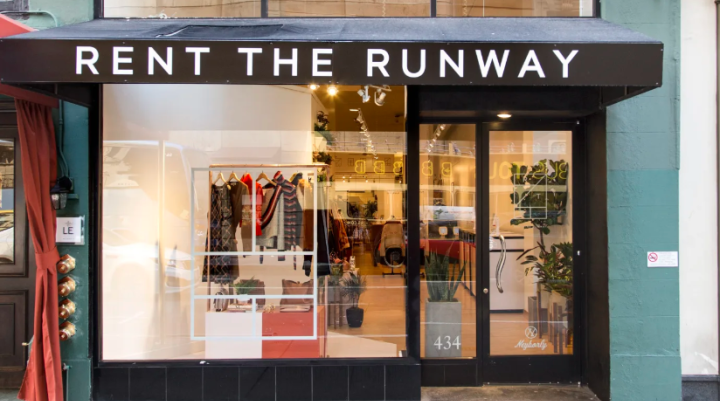Leading clothing rental platform Rent the Runway has secured a major partnership with Amazon Fashion. The global retail behemoth will launch a Rent the Runway storefront on the marketplace’s website. Offering Amazon shoppers access to thousands of gently used rental fashion and new items from The Design Collective range. The Rent the Runway store on Amazon will sell hundreds of styles from its inventory including categories such as casual wear, workwear, and occasional wear.
p; Along with an exclusive selection from the RTR Design Collective range, which consists of high quality fashion created by emerging designers leveraging RTR’s member data and industry trends.
A partnership of this calibre is game changing for Rent the Runway as it positions the brand in front of a new audience and provides a crucial channel to move thousands of its rental items no longer fit for purpose into the hands of pre-loved fashion shoppers. Additionally the partnership creates a reliable revenue stream for the established rental business.
“Collaborating with Amazon Fashion brings Rent the Runway incredible brand awareness. We believe strategic relationships like this can ignite a new engine of growth for our business. They also showcase demand for our products beyond our community and allow more customers to experience exclusive data-driven fashion from our top design partners,” said Jenn Hyman, Rent the Runway’s co-founder and CEO.
The collaboration with Amazon adds to Rent the Runway’s strategy of leveraging established marketplaces. In July 2020, Rent the Runway joined forces with ThredUp, one of America’s leading online consignment and thrift stores as a means of selling RTR’s used clothing. And in 2022, RTR struck a deal with Saks Off 5th, selling a curated collection of pre-owned designer clothing from Rent the Runway.
It’s no surprise that clothing rental took a significant hit with local lockdowns restricting many events and going to the office, which spurred the need for renting quality garments. Raising questions around the popularity of fashion rental as we recover from the global pandemic and highlights the need for new revenue streams to accelerate financial recovery.
State of fashion rental
In a recent case study produced by Taylor Brydges, Lisa Heinze, Monique Retamal, and Claudia E. Henninger, whose research delves into the impact of Covid-19 on clothing rental platforms. Their findings place a spotlight on how an innovative business model was essentially flattened overnight. Interestingly, the case study mentions an Australian rental platform who reported sales in March 2020 drastically reducing from $3,500 to less than $300 a day.
In late April 2020, Business Insider shared that RTR had furloughed 35% of its staff along with significant reductions to budgets and management salaries. Then in 2022, RTR made an announcement it was restructuring to reduce costs, which resulted in cutting 24 percent of corporate employees. The rental platform remains unprofitable, placing immense pressure on RTR to expand its offering to attract new audiences.
With lockdowns in the past, people heading to the office and events back on our calendars, fashion rental is again a useful alternative to buying new clothes for work and special occasions. However, the significant disruption to fashion rental has forced platforms to explore adding reliable retail channels to future proof its existence.
The category showing exponential growth in this space is resale, and makes sense for Rent the Runway to responsibly move used rental fashion onto credible partners, keeping clothing in circulation for longer. As it’s become clear that fashion rental as a standalone model has too many risks attached to it.
Sustainability or profitability
Initially, fashion rental entered the scene as a viable sustainable solution to buying new, specifically in categories such as workwear and special occasion wear. Many platforms around the world jumped on the trend, building the customer base and inventory in parallel. However, sustainability experts were quick to shine a light on the very unsustainable aspects to fashion rental including the impact of regular dry cleaning and costs associated with transporting clothing back and forth with each transaction.
As for the value exchange within the partnership, there are several advantages for Rent the Runway getting access to Amazon, but what does the retail giant gain from RTR? Along with RTR’s 8 million customer base, Amazon is one of the largest retailers in the world and its mission is to ‘serve consumers through online and physical stores and focus on selection, price, and convenience.’
By integrating merchandise from RTR, Amazon is laser focused on expanding its product offering, such as fashion while appealing to dollar conscious shoppers. It’s an added bonus that the partnership aids in extending the life of clothing, which if analysed appropriately would show a positive impact on the environment. Although, it is not a guiding factor for Amazon as it continues to dominate the retail sector. Forecasts point to Amazon’s retail ecommerce sales reaching $746.22 billion this year. It is very much about profitability over sustainability.
Fortunately, with consumers demanding brands do better for the environment, pledges and initiatives are taken seriously and not all attempts to implement sustainability programs are greenwashing campaigns. Organisations and publications are holding brands accountable, and through considerable change and collaborations, businesses are adopting circular practices in fashion, resulting in substantial improvements to the entire industry.







